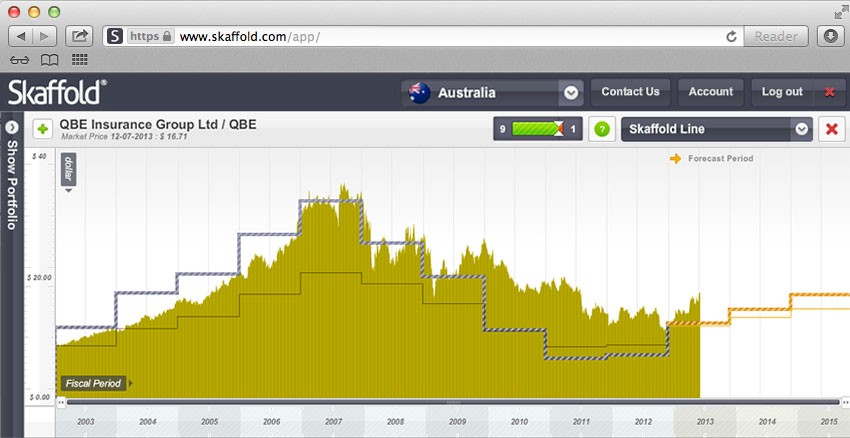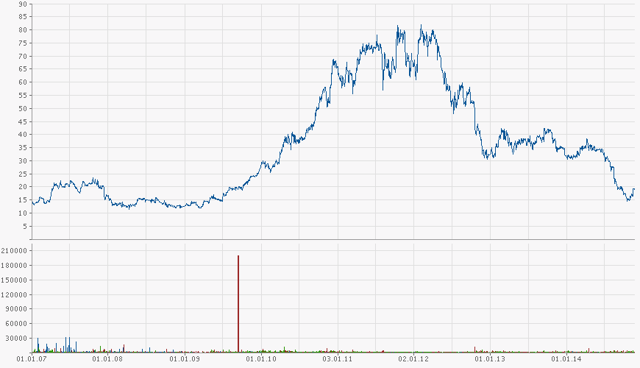Value investments or value traps
Post on: 24 Апрель, 2015 No Comment

Quality stocks trading at a discount to intrinsic value should be good investments, but how do you know if they are value traps?
As an astute share investor you should always be on the hunt for great value-plays or quality stocks trading at a discount to their intrinsic value. But if you dont keep an eye on a stocks underlying business, and where the profits are coming from, what you thought was a buying opportunity could turn out to be an accident waiting to happen.
Commonly referred to as value-traps, these are stocks that you may have bought into when they appeared to be cheap based on (low) multiples of earnings, cash flow or book value and trading at a bright green positive safety margin. However, if after an extended time period the stock never improves, theres a strong likelihood that youve fallen into a value trap that needs to be dealt with before it gets any worse.
Price earnings ratio is not the only indicator
The lesson for new or misinformed share investors is that a big safety margin or low price earnings ratio (P/E) doesnt always mean ‘cheap’. And while some stocks trade at a significant premium to their value for good reason, the opposite can also be true.
So as a litmus test of value, the price earnings ratio can be and often is highly misleading. Take for example insurers, cyclical businesses, and the materials sector, where the businesses often have high profits and consequently low price earnings ratios at the very moment when conditions are at their best.
Sadly, investors who are drawn to shares under the psychological $1 barrier often confuse affordability with value. Similarly, many investors consider ‘blue chip’ companies with a strong brand name, high profile and a long history of good performance as perennial bellwethers when theyre not.
Due to any number of factors, whether its poor management, deteriorating economic factors or industry-related issues, stocks that become value-traps are frequently unable to survive in the face of new competition or generate substantial and consistent profits, and often lack new products or earnings growth.
The danger of holding onto an emerging value-trap is that by the time the companys deteriorating fortunes become obvious to the broader market, the gap between the price you bought the stock at and its value is getting wider.
Value changes with changing results
Reporting seasons can be full of surprises, so be on the lookout for stocks with disappointing results, together with negative commentary on the outlook for a business or the competitive edge it once enjoyed. The trick is to anticipate what damage reporting season will have on a stocks value before any re-ratings occur.
Many investors will be surprised to see the discount to value they thought some companies were trading at look totally different by years end.
So while one sector might look attractive when compared with current earnings, weakness in commodity prices and other macro headwinds pose major risks in buying these stocks going forward.
Examples of quality insurers that have suffered from deteriorating business performance and value include: Insurance Australia Group (IAG) and QBE Insurance.
In 2007 QBE reported earnings per share of $2.26, and by December 2012 it had fallen to $0.73. Over that same period profit has declined by more than $100 million, while debt has increased to over 25 per cent of the companys total equity. From a peak of $31.78 in 2007, QBEs underlying value has fallen by around 60 per cent.
Skaffold Line chart plots QBEs intrinsic value and share price (at 12 July 2013) .
Insurance Australia Group (IAG)
In the case of IAG, the companys return on equity (a strong measure of profitability), went from over 20 per cent between 2004 and 2006 to less than half that by mid 2012. But despite declining earnings, the company continued to pay a dividend. When cash dried up the company took on debt and in 2008 ROE fell to 0.14 per cent. Unsurprisingly, over the same period the companys share price virtually halved.
Skaffold Line chart plots IAGs intrinsic value and share price (at 12 July 2013) .
Finding emerging value traps
Lets take a look at companies that have traded at a discount, and where future valuations are forecast to decline.
Diversified services company Monadelphous Group (MND) looks like an attractive buy. But while its intrinsic value has increased 45 per cent per annum over the past nine years, it is forecast to decrease just over 12 per cent over the next two years. So while MNDs 30 per cent discount to value looks compelling, you should be concerned that this may indeed widen based on deteriorating conditions for the sector.

Skaffold Line chart plots MNDs intrinsic value and share price (at 12 July 2013) .
Then theres taxicab payment operator, Cabcharge (CAB) which due to the erosion of its virtual monopoly status is forecast to see its intrinsic value (up 13.5 per cent per annum over the last nine years) decrease by around 10 per cent per annum over the next two years. Given these dynamics, the current circa 40 per cent gap between price and value is concerning.
Skaffold Line chart plots CABs intrinsic value and share price (at 12 July 2013) .
It would have been inconceivable five years ago to suggest that retail darling JB Hi-Fi (JBH) could be a value trap in waiting, but recent developments are concerning.
Skaffold Line chart plots JBHs intrinsic value and share price (at 12 July 2013).
Monadelphous, Cabcharge and JB Hi-Fi have a few things in common when you see them in Skaffold. First, their Skaffold Line charts are bright green theyre all historically strong businesses, and right now are trading at positive safety margins.
On the negative side, looking at their Skaffold Verdict we can see that the future change in value forecast is negative.
Evaluate Future Value for a look ahead
Future Value. also known as FV or Forecast change in Value, is the forecast percentage of annual growth (or decline) in value for a company. Change in Future Value estimates will change as Skaffold’s future intrinsic value estimates change.
A business may have a great track record, and in many cases the future looks just as promising. However businesses are dynamic. Economic environments impact business models, consumer sentiment changes and businesses that fail to adapt can be left behind.














